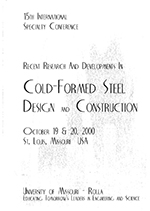Session Dates
19 Oct 2000
Abstract
The paper presents a comparison of web crippling tests of cold-formed unlipped channels with flanges restrained or unrestrained. The tests were performed under end and interior two-flange loading conditions specified in the Australian/New Zealand Standard (AS/NZS 4600, 1996) and the American Iron and Steel Institute (AISI, 1996) Specification for cold-formed steel structures, namely End-Two-Flange (ETF) and Interior-Two-Flange (ITF) loading conditions. The concentrated load was applied by a bearing plate at the top flange of the channels, and the reaction force applied by an identical bearing plate at the bottom flange of the channels. The bearing plates acted across the full flange widths of the channels. The flanges of the channels were bolted to the bearing plates for the specimens with flanges restrained. The web crippling test strengths are compared with the current design strengths obtained using the AS/NZS 4600 and the AISI Specification. It is shown that the design strengths predicted by the specifications are unconservative for the tested channels with flanges restrained or unrestrained.
Department(s)
Civil, Architectural and Environmental Engineering
Research Center/Lab(s)
Wei-Wen Yu Center for Cold-Formed Steel Structures
Meeting Name
15th International Specialty Conference on Cold-Formed Steel Structures
Publisher
University of Missouri--Rolla
Document Version
Final Version
Rights
© 2000 University of Missouri--Rolla, All rights reserved.
Document Type
Article - Conference proceedings
File Type
text
Language
English
Recommended Citation
Young, Ben and Hancock, Gregory J., "Web Crippling Behaviour of Channels with Flanges Restrained" (2000). CCFSS Proceedings of International Specialty Conference on Cold-Formed Steel Structures (1971 - 2018). 5.
https://scholarsmine.mst.edu/isccss/15iccfss/15iccfss-session2/5
Web Crippling Behaviour of Channels with Flanges Restrained
The paper presents a comparison of web crippling tests of cold-formed unlipped channels with flanges restrained or unrestrained. The tests were performed under end and interior two-flange loading conditions specified in the Australian/New Zealand Standard (AS/NZS 4600, 1996) and the American Iron and Steel Institute (AISI, 1996) Specification for cold-formed steel structures, namely End-Two-Flange (ETF) and Interior-Two-Flange (ITF) loading conditions. The concentrated load was applied by a bearing plate at the top flange of the channels, and the reaction force applied by an identical bearing plate at the bottom flange of the channels. The bearing plates acted across the full flange widths of the channels. The flanges of the channels were bolted to the bearing plates for the specimens with flanges restrained. The web crippling test strengths are compared with the current design strengths obtained using the AS/NZS 4600 and the AISI Specification. It is shown that the design strengths predicted by the specifications are unconservative for the tested channels with flanges restrained or unrestrained.



